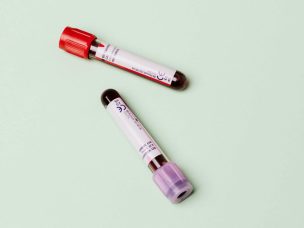Introduction
Atrial fibrillation occurs more often in people with the following physical conditions and lifestyle characteristics [1,2]:
- Fifty years of age and older
- High alcohol consumption
- Use of illegal drugs
- Chronic obstructive pulmonary disease (COPD)
- Smoking or vaping
- High levels of physical and/or emotional stress
- Heart failure
- High blood pressure
- Obesity
- Sleep apnea or poor sleep
- Thyroid disease
Healthcare providers may screen for atrial fibrillation during routine medical checkups, but especially if known risk factors are present. This is especially likely to be part of routine checkups if the patient is older than 65 years of age [3].
Screening includes gathering information about an individual’s medical and family history, a physical exam, an electrocardiogram (EKG), and other relevant tests and procedures.
Screening may include the following [1,4]:
Discussions about medical and family history
The healthcare provider will ask about routine eating habits and physical activity, family history, and other known risk factors for atrial fibrillation and heart disease. This information can help determine whether other conditions should be considered when determining the cause of atrial fibrillation.
Physical examination
Your physician will perform a complete physical examination, paying close attention to your heart and lungs. During this examination, they will check for signs of hyperthyroidism; swelling of the legs, ankles, or feet, which could be a sign of an enlarged heart that doesn’t pump blood properly; and also listen to your lungs to check for indications of heart failure or infection.
Diagnostic tests
Electrocardiograms, or EKGs, record a heart’s electrical activity. The results provide information about:
- Heart rate and rhythm
- How the heart’s electrical signals travel
- The parts of the heart that are triggering contractions
Laboratory tests check the levels of specific substances, including potassium and thyroid hormone. These can help determine the cause of the atrial fibrillation and show how well the liver and kidneys are working. This information helps your healthcare provider choose the most appropriate and effective medication to prescribe.
Echocardiography (ultrasound) provides information about the heart valves, chamber sizes, and heart pumping function. This test may show heart valve disease, areas of heart muscle that are not pumping normally, and any previous injury to the heart muscle caused by poor blood flow. It may also identify harmful blood clots in the heart’s chambers.
Cardiac Magnetic Resonance Imaging (MRI) and other imaging tests may be performed to assess the structure of the left upper chamber of the heart (left atrium) and how well it is working. This information can help determine the risk level for complications from atrial fibrillation. The images may also identify other potential causes of atrial fibrillation and enable providers to create an individualized treatment plan.
Additional diagnostic tests are available, including [1,5,6]:
Chest X-rays look for signs of complications from atrial fibrillation, such as fluid buildup in the lungs or an enlarged heart.
An electrophysiology study records cardiac electrical signals, providing more detail about what is causing a particular EKG reading or helping to distinguish among possible types of arrhythmias.
Holter monitors record the heart’s electrical activity over long periods during the performance of normal activities. These portable EKG monitors help assess the cause of symptoms, like palpitations or dizziness, that happen outside the healthcare provider’s office.
Event recorder. This device is like a Holter monitor, but it records only at certain time intervals for a few minutes at a time. It is typically worn for about 30 days, and the wearer just pushes a button whenever symptoms are felt. Some devices will automatically record when an irregular heart rhythm is detected.
Implantable loop recorder. This device records the heartbeat continuously for up to three years. It is also called a cardiac event recorder. It shows how the heart is beating during daily activities. It may be used to see how often an AFib episode occurs. Sometimes it’s used to find rare episodes of AFib for those at high risk.
Trans-telephonic monitor: A strip of a monitored heart rhythm is transmitted to the doctor’s office over the phone when symptoms of atrial fibrillation develop using a monitor with two bracelets or by placing the monitor against the chest wall.
A sleep study can determine whether sleep disorders such as sleep apnea might be causing Afib symptoms.
A stress test, or exercise stress test, studies changes in cardiac activity that occur when the heart rate increases after exercise.
Transesophageal echocardiography checks for blood clots that may be forming in the heart’s upper chambers because of atrial fibrillation. This is achieved by passing sound waves through the esophagus to create images of the heart.
A walking test measures heart activity while walking for 6 minutes. This can help determine how well the heart rate is controlled under normal circumstances.
The results of these tests will confirm the diagnosis of Afib, its severity, damage, and prognosis, as well as provide a roadmap for treatment and follow-up, including lifestyle changes.
Sources:
- What is AFIB? (2023c, April 28). Johns Hopkins Medicine. https://www.hopkinsmedicine.org/health/conditions-and-diseases/atrial-fibrillation
- Causes and risk factors | NHLBI, NIH. (2022c, November 30). NHLBI, NIH. https://www.nhlbi.nih.gov/health/atrial-fibrillation/causes
- Morillo, C. A., Banerjee, A., Perel, P., Wood, D., & Jouven, X. (2017e). Atrial fibrillation: the current epidemic. Journal of Geriatric Cardiology, 14(3), 195–203. https://doi.org/10.11909/j.issn.1671-5411.2017.03.011
- Diagnosis | NHLBI, NIH. (2022, November 30). NHLBI, NIH. https://www.nhlbi.nih.gov/health/atrial-fibrillation/diagnosis
- Atrial fibrillation – Diagnosis and treatment – Mayo Clinic. (2023c, July 26). https://www.mayoclinic.org/diseases-conditions/atrial-fibrillation/diagnosis-treatment/drc-20350630
- Atrial Fibrillation Treatment Guide | Cleveland Clinic. (n.d.-g). Cleveland Clinic. https://my.clevelandclinic.org/treatment-guides/14-0081-afib-guide#diagnosis-tab










